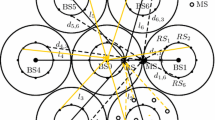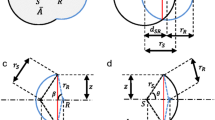Abstract
Energy efficiency (EE) of cellular networks has received considerable attention recently. However, EE of relay-assisted cellular networks has not been thoroughly addressed, especially the tradeoff between EE and spectral efficiency (SE). In this paper, considering downlink transmission in a single cell of a relay-assisted cellular network with symmetric relay deployment, and modeling the locations of mobile users as a spatial Poisson point process, a simple geometric model is built to analyze the EE. A metric defined as the ratio of average area throughput to average area power consumption is used to measure the average EE and its analytical expression is derived. The tradeoff between the average EE and the average SE is formulated as an optimization problem to which the closed-form solution is difficult to obtain. Through numerical simulations, the impact of the number of relay stations (RSs) and the location parameter of RSs on the average EE are evaluated. The results show that in some cases the average EE is a quasi-concave function of the number of RSs or the location parameter of RSs.










Similar content being viewed by others
References
Eunsung, O., Krishnamachari, B., Liu, X., & Niu, Z. (2011). Toward dynamic energy-efficient operation of cellular network infrastructure. IEEE Communications Magazine, 49(6), 56–61.
Louhi, J. (2007). Energy efficiency of modern cellular base stations. In Proceedings of the 29th international telecommunications energy conference (INTELEC’07) (pp. 475–476). Rome: IEEE.
Hu, R., & Qian, Y. (2014). An energy efficient and spectrum efficient wireless heterogeneous network framework for 5G systems. IEEE Communications Magazine, 52(5), 94–101.
Niu, Z., Wu, Y., Gong, J., & Yang, Z. (2010). Cell zooming for cost-efficient green cellular networks. IEEE Communications Magazine, 48(11), 74–79.
Wu, W., Xiang, W., Zhang, Y., Zheng, K., & Wang, W. (2015). Performance analysis of device-to-device communications underlaying cellular networks. Telecommunication Systems, 60(1), 29–41.
Sydir, J., & Taori, R. (2009). An evolved cellular system architecture incorporating relay stations. IEEE Communications Magazine, 47(6), 115–121.
ElSawy, H., Hossain, E., & Haenggi, M. (2013). Stochastic geometry for modeling, analysis, and design of multi-tier and cognitive cellular wireless networks: a survey. IEEE Communications Surveys & Tutorials, 15(3), 996–1019.
Deng, N., Zhang, S., Zhou, W., & Zhu, J. (2012). A stochastic geometry approach to energy efficiency in relay-assisted cellular networks. In Proceedings of the IEEE global telecommunications conference(GLOBECOM’12) (pp. 3484–3489). Anaheim: IEEE.
Yu, H., Li, Y., Kountouris, M., Xu, X., & Wang, J. (2014). Energy efficiency analysis of relay-assisted cellular networks using stochastic geometry. In Proceedings of the 12th international symposium on modeling and optimization in mobile, ad hoc, and wireless networks (WiOpt’14) (pp. 667–671). Hammamet: IEEE.
Yu, H., Li, Y., Xu, X., & Wang, J. (2014). Energy harvesting relay-assisted cellular networks based on stochastic geometry approach. In Proceedings of the international conference on intelligent green building and smart grid (IGBSG’14) (pp. 1–6). Taipei: IEEE.
Misra, S., Hong, S., Xue, G., & Tang, J. (2010). Constrained relay node placement in wireless sensor networks: Formulation and approximations. IEEE/ACM Transactions on Networking, 18(2), 434–447.
Wu, D., Chatzigeorgiou, D., Youcef-Toumim, K., Mekid, S., & Ben-Mansour, R. (2014). Channel-aware relay node placement in wireless sensor networks for pipeline inspection. IEEE Transactions on Wireless Communications, 13(7), 3510–3523.
Yang, Z., Zhang, Q., & Niu, Z. (2012). Throughput improvement by joint relay selection and link scheduling in relay-assisted cellular networks. IEEE Transactions on Vehicular Technology, 61(6), 2824–2835.
Yang, Z., & Niu, Z. (2013). Load balancing by dynamic base station relay station associations in cellular networks. IEEE Wireless Communications Letters, 2(2), 155–158.
Guo, W., & O’Farrell, T. (2013). Relay deployment in cellular networks: Planning and optimization. IEEE Journal on Selected Areas in Communications, 31(8), 1597–1606.
Pourahmadi, V., Fashandi, S., Saleh, A., & Khandani, A. (2011). Relay placement in wireless networks: A study of the underlying tradeoffs. IEEE Transactions on Wireless Communications, 10(5), 1383–1388.
Minelli, M., Ma, M., Coupechoux, M., Kelif, J., Sigelle, M., & Godlewski, P. (2014). Optimal relay placement in cellular networks. IEEE Transactions on Wireless Communications, 13(2), 998–1009.
Khakurel, S., Mehta, M., & Karandikar, A. (2012). Optimal relay placement for coverage extension in LTE-A cellular systems. In Proceedings of the national conference on communications (NCC’12) (pp. 1–5). Kharagpur: IEEE.
Wang, L., Su, W., Huang, J., Chen, A., & Chang, C. (2008). Optimal relay location in multi-hop cellular systems. In Proceedings of the IEEE wireless communications and networking conference (WCNC’08) (pp. 1306–1310). Las Vegas: IEEE .
Li, Y., Zhu, X., Liao, C., Wang, C., & Cao, B. (2015). Energy efficiency maximization by jointly optimizing the positions and serving range of relay stations in cellular networks. IEEE Transactions on Vehicular Technology, 64(6), 2551–2560.
Wu, G., & Feng, G. (2012). Energy-efficient relay deployment in next generation cellular networks. In: Proceedings of the IEEE international conference on communications (ICC’12) (pp. 5757–5761). Ottawa: IEEE.
So, A., & Liang, B. (2007). Enhancing WLAN capacity by strategic placement of tetherless relay points. IEEE Transactions on Mobile Computing, 6(5), 522–535.
Niyato, D., & Hossain, E. (2007). Integration of IEEE 802.11 WLANs with IEEE 802.16-based multihop infrastructure mesh/relay networks: a game-theoretic approach to radio resource management. IEEE Network, 21(3), 6–14.
Lu, H., Liao, W., & Lin, F. (2011). Relay station placement strategy in IEEE 802.16j WiMAX networks. IEEE Transactions on Communications, 59(1), 151–158.
Yang, D., Fang, X., & Xue, G. (2011). Near-optimal relay station placement for power minimization in WiMAX networks. In Proceedings of the IEEE global telecommunications conference (GLOBECOM’11) (pp. 1–5). Houston: IEEE.
Devarajan, R., Jha, S., Phuyal, U., & Bhargava, V. (2012). Energy-aware resource allocation for cooperative cellular network using multi-objective optimization approach. IEEE Transactions on Wireless Communications, 11(5), 1797–1807.
Rini, S., Kurniawan, E., Ghaghanidze, L., & Goldsmith, A. (2014). Energy efficient cooperative strategies for relay-assisted downlink cellular systems. IEEE Journal on Selected Areas in Communications, 32(11), 2075–2089.
Wu, D., Zhou, L., Cai, Y., Hu, R., & Qian, Y. (2014). Energy-aware dynamic cooperative strategy selection for relay-assisted cellular networks: an evolutionary game approach. IEEE Transactions on Vehicular Technology, 63(9), 4659–4669.
Liu, G., Yu, F., Ji, H., & Leung, V. (2015). Energy-efficient resource allocation in cellular networks with shared full-duplex relaying. IEEE Transactions on Vehicular Technology, 64(8), 3711–3724.
Ku, I., Wang, C., & Thompson, J. (2013). Spectral-energy efficiency tradeoff in relay-aided cellular networks. IEEE Transactions on Wireless Communications, 12(10), 4970–4982.
Xiong, C., Li, Y., Zhang, S., Chen, Y., & Xu, S. (2011). Energy- and spectral-efficiency tradeoff in downlink OFDMA networks. IEEE Transactions on Wireless Communications, 10(11), 3874–3886.
Huang, S., Chen, H., Cai, J., & Zhao, F. (2013). Energy efficiency and spectral-efficiency tradeoff in amplify-and-forward relay networks. IEEE Transactions on Vehicular Technology, 62(9), 4366–4378.
Cheung, K., Yang, S., & Hanzo, L. (2013). Achieving maximum energy efficiency in multi-relay OFDMA cellular networks: A fractional programming approach. IEEE Transactions on Communications, 61(7), 2746–2757.
Tang, J., So, D., Alsusa, E., & Hamdi, K. (2014). Resource efficiency: A new paradigm on energy efficiency and spectral efficiency tradeoff. IEEE Transactions on Wireless Communications, 13(8), 4656–4669.
Cheung, K., Yang, S., & Hanzo, L. (2014). Spectral and energy efficiency optimization of joint transmit and receive beamforming based multi-relay MIMO-OFDMA cellular networks. IEEE Transactions on Wireless Communications, 13(11), 6147–6165.
Andrews, J., Baccelli, F., & Ganti, R. (2011). A tractable approach to coverage and rate in cellular networks. IEEE Transactions on Communications, 59(11), 3122–3134.
Peng, J., Hong, P., & Xue, K. (2015). Energy-aware cellular deployment strategy under coverage performance constraints. IEEE Transactions on Wireless Communications, 14(1), 69–80.
Samarasinghe, T., Inaltekin, H., & Evans, J. (2014). On optimal downlink coverage in Poisson cellular networks with power density constraints. IEEE Transactions on Communications, 62(4), 1382–1392.
Ge, X., Yang, B., Ye, J., Mao, G., Wang, C., & Han, T. (2015). Spatial spectrum and Energy efficiency of random cellular networks. IEEE Transactions on Communications, 63(3), 1019–1030.
Xiang, L., Ge, X., Wang, C.-X., Li, F. Y., & Reichert, F. (2013). Energy efficiency evaluation of cellular networks based on spatial distributions of traffic load and power consumption. IEEE Transactions on Wireless Communications, 12(3), 961–973.
Peng, J., Tang, H., Hong, P., & Xue, K. (2013). Stochastic geometry analysis of energy efficiency in heterogeneous network with sleep control. IEEE Wireless Communications Letters, 2(6), 615–618.
Yu, H., Li, Y., Kountouris, M., Xu, X., & Wang, J. (2014). Energy efficiency analysis of relay-assisted cellular networks. EURASIP Journal on Advances in Signal Processing, 2014, 1–11.
Haenggi, M., Andrews, J., Baccelli, F., Dousse, O., & Franceschetti, M. (2009). Stochastic geometry and random graphs for the analysis and design of wireless networks. IEEE Journal on Selected Areas in Communications, 27(7), 1029–1046.
Acknowledgments
This work was supported in part by the National Natural Science Foundation of China under Grant: 61162008, 61172055, 61471135, the Guangxi Natural Science Foundation under Grant: 2013GXNSFGA019004, 2015GXNSFBB139007, the Director Fund of Key Laboratory of Cognitive Radio and Information Processing (Guilin University of Electronic Technology), Ministry of Education, China under Grant: 2013ZR02, the Fund of Guangxi Key Laboratory of Wireless Wideband Communication and Signal Processing under Grant: CRKL150104, and the Innovation Project of Guangxi Graduate Education under Grant: YCSZ2015144.
Author information
Authors and Affiliations
Corresponding author
Rights and permissions
About this article
Cite this article
Chen, H., Chen, W., Zhao, F. et al. Stochastic geometry analysis of downlink energy efficiency for a relay deployment scheme in relay-assisted cellular networks. Telecommun Syst 63, 263–273 (2016). https://doi.org/10.1007/s11235-015-0118-2
Published:
Issue Date:
DOI: https://doi.org/10.1007/s11235-015-0118-2




